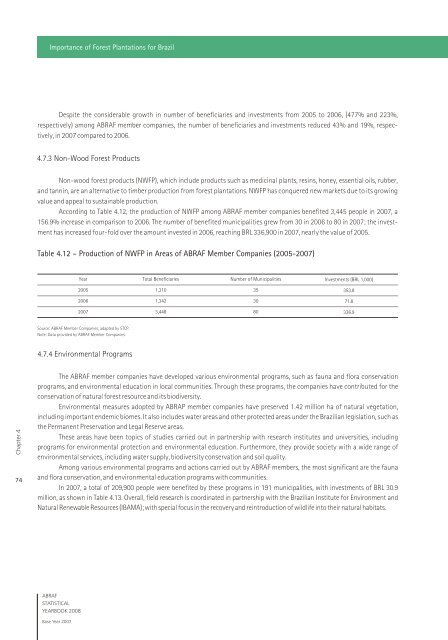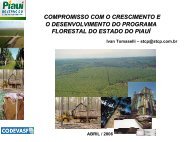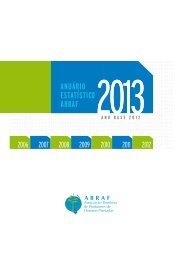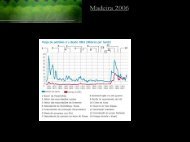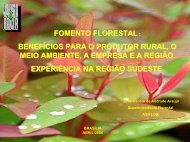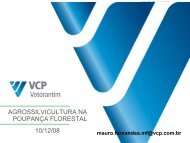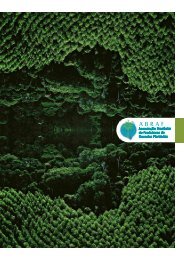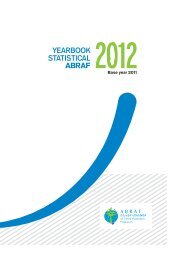ABRAF STATISTICAL YEARBOOK - Associação Brasileira de ...
ABRAF STATISTICAL YEARBOOK - Associação Brasileira de ...
ABRAF STATISTICAL YEARBOOK - Associação Brasileira de ...
You also want an ePaper? Increase the reach of your titles
YUMPU automatically turns print PDFs into web optimized ePapers that Google loves.
Importance of Forest Plantations for BrazilDespite the consi<strong>de</strong>rable growth in number of beneficiaries and investments from 2005 to 2006, (477% and 223%,respectively) among <strong>ABRAF</strong> member companies, the number of beneficiaries and investments reduced 43% and 19%, respectively,in 2007 compared to 2006.4.7.3 Non-Wood Forest ProductsNon-wood forest products (NWFP), which inclu<strong>de</strong> products such as medicinal plants, resins, honey, essential oils, rubber,and tannin, are an alternative to timber production from forest plantations. NWFP has conquered new markets due to its growingvalue and appeal to sustainable production.According to Table 4.12, the production of NWFP among <strong>ABRAF</strong> member companies benefited 3,445 people in 2007, a156.9% increase in comparison to 2006. The number of benefited municipalities grew from 30 in 2006 to 80 in 2007; the investmenthas increased four-fold over the amount invested in 2006, reaching BRL 336,900 in 2007, nearly the value of 2005.Table 4.12 – Production of NWFP in Areas of <strong>ABRAF</strong> Member Companies (2005-2007)YearTotal BeneficiariesNumber of MunicipalitiesInvestments (BRL 1,000)20051,31035353.820061,3423071.820073,44880336.9Source: <strong>ABRAF</strong> Member Companies; adapted by STCP.Note: Data provi<strong>de</strong>d by <strong>ABRAF</strong> Member Companies.4.7.4 Environmental ProgramsChapter 474The <strong>ABRAF</strong> member companies have <strong>de</strong>veloped various environmental programs, such as fauna and flora conservationprograms, and environmental education in local communities. Through these programs, the companies have contributed for theconservation of natural forest resource and its biodiversity.Environmental measures adopted by ABRAP member companies have preserved 1.42 million ha of natural vegetation,including important en<strong>de</strong>mic biomes. It also inclu<strong>de</strong>s water areas and other protected areas un<strong>de</strong>r the Brazilian legislation, such asthe Permanent Preservation and Legal Reserve areas.These areas have been topics of studies carried out in partnership with research institutes and universities, includingprograms for environmental protection and environmental education. Furthermore, they provi<strong>de</strong> society with a wi<strong>de</strong> range ofenvironmental services, including water supply, biodiversity conservation and soil quality.Among various environmental programs and actions carried out by <strong>ABRAF</strong> members, the most significant are the faunaand flora conservation, and environmental education programs with communities.In 2007, a total of 209,900 people were benefited by these programs in 191 municipalities, with investments of BRL 30.9million, as shown in Table 4.13. Overall, field research is coordinated in partnership with the Brazilian Institute for Environment andNatural Renewable Resources (IBAMA); with special focus in the recovery and reintroduction of wildlife into their natural habitats.<strong>ABRAF</strong><strong>STATISTICAL</strong><strong>YEARBOOK</strong> 2008Base Year 2007


